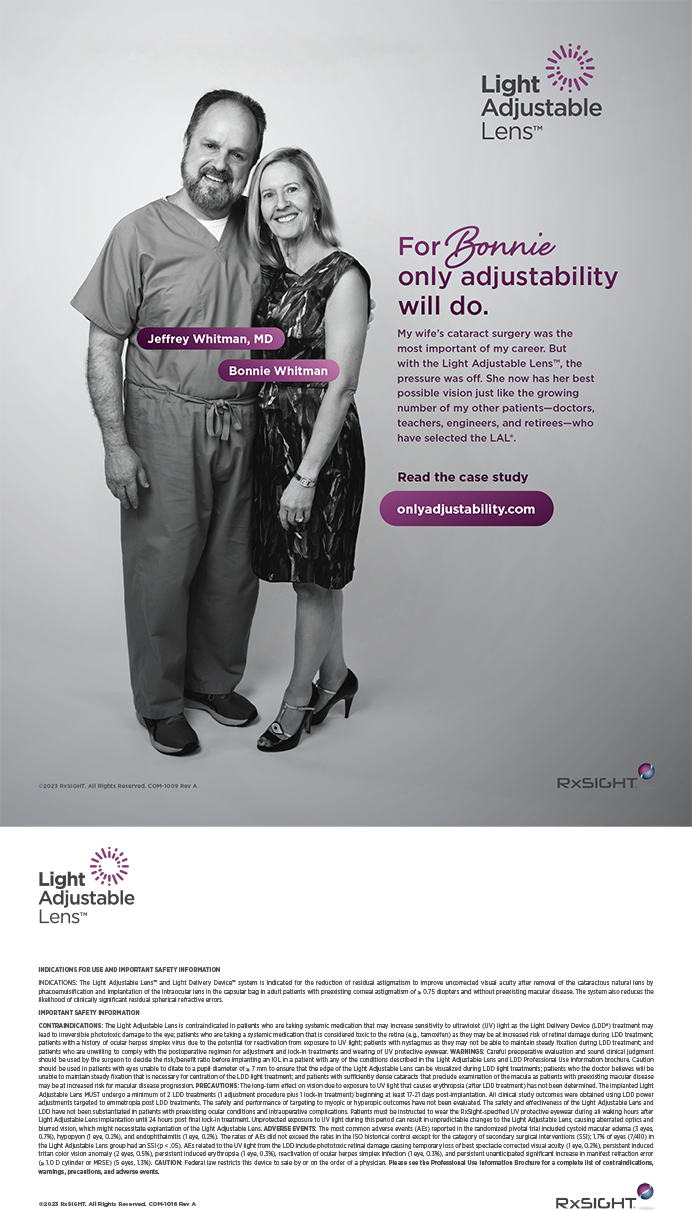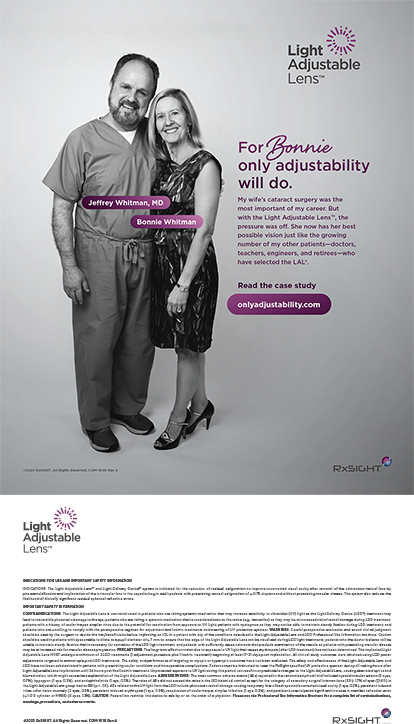The Future of Reimbursement: Looking to the Past for Hope for the Future
A young surgeon notes four key events in ophthalmology’s history that preserved the potential for innovation and investment in patients’ visual options.

BY O. BENNETT WALTON IV, MD, MBA
In July, the CMS released a proposed rule that will affect the Medicare Physician Fee Schedule for 2020. If the rule is finalized as is, reimbursement for cataract surgery (CPT code 66984) will be reduced from $654.47 to $557.58—a 15% cut in payment with no changes in the requirements or costs of the procedure.1
According to Nancey McCann, director of government relations for ASCRS, the rationale for the reduction was that average surgical time has shortened, and some surgeons are combining what used to be separate 1-week and 1-month postoperative visits within the global period. After explaining the intensity and complexity of the surgery, Ms. McCann and others on the government relations team were able to negotiate a proposed nearly 50% reduction down to a reduction of 15%.
According to Ms. McCann, one of the main triggers for the revaluation of cataract surgery by the CMS was the frequency with which endoscopic cyclophotocoagulation (ECP) was being performed with cataract surgery. As a result, the entire family of codes was flagged for revaluation. I don’t think many surgeons would say ECP is inappropriate. In fact, the entire field of microinvasive glaucoma surgery (MIGS) has made a huge improvement in how we address glaucoma. Industry and surgeons alike need to be aware, however, of the triggers for revaluation, such as high frequency of utilization.
REIMBURSEMENT IN 2020
Cataract math in 2020 is disappointing, to say the least. If a practice had an overhead of 71% before the reimbursement cut—a common overhead for many ophthalmology practices—a 15% reduction in reimbursement reduces take-home profit from cataract surgery by a whopping 51%.
Yes, surgeons are doing better, cleaner, more technologically intensive surgery. Yes, patients have better outcomes with modern cataract surgery than ever before. And yes, reimbursement for cataract surgery is a fraction of what it has been in the past, before even considering the effects of inflation. The reality is, reducing the reimbursement for cataract surgery by $1 saves the CMS more money or redirects more money to primary care than reducing any other surgery by $1 simply because of the number of surgeries needed by our patients.
A cut such as this, to under the $600 threshold, is a big event for all US ophthalmic surgeons. To provide a generational perspective on reimbursement and to offer some hope in the frustrating reality that we face, it is helpful to recall four positive key events in physician reimbursement in the past few decades.
We don’t need a reminder of the emergence of phacoemulsification, which faced hostility from the ophthalmology establishment. Phacoemulsification didn’t directly affect reimbursement, but it is an example of a fierce debate that was settled over time. Decades of debate regarding phacoemulsification versus extracapsular cataract surgery occurred before phacoemulsification ultimately won; however, phacoemulsification had won in clinical practice long before it won in the literature.2
EVENT NO. 1: Beloved actor saves iols
In the early 1970s, the use of IOLs to treat aphakia after cataract surgery faced heavy resistance. The FDA even convened a hearing to contemplate outlawing the use of IOLs entirely.3 Many established ophthalmologists and professional societies vehemently opposed the use of IOLs.
Richard Kratz, MD, whose 1965 testimony in front of the US Senate had protected the ability of ophthalmologists to fit glasses and contact lenses, was a proponent of IOLs in the 1970s. Dr. Kratz brought his patient, actor Robert Young, famous for playing the title role in the TV show Marcus Welby, M.D., to that FDA hearing. Mr. Young testified there that his acting career had been saved by IOLs. He explained that, with IOLs, he was able to continue to act without wearing enormous aphakic spectacles on the set, thereby preserving his familiar appearance. IOLs were not outlawed. Ultimately, correction of aphakia after cataract surgery became a covered service, first as a separate reimbursement and later bundled.
EVENT NO. 2: Presbyopia correction as a premium service during cataract surgery
Surgeons in their mid-40s or younger, myself included, have spent our careers practicing after the CMS ruling of May 2005, which allowed presbyopia correction with patient-shared billing for Medicare patients at the time of cataract surgery. At the time, Andy Corley was the CEO of lens maker Eyeonics, and he was one of the principal architects of this opening of the cataract premium channel. He had earlier helped establish the refractive surgery market as the president of Chiron Vision. Interfacing with the CMS was a different beast, however. It was a 5-year uphill battle that seemed like a long shot. After all, many ophthalmologists opposed the development because they had no CMS guidance on addressing presbyopia at the time.4
“The principles were simple,” he said. “Covered services are covered, and noncovered services are not. Therefore, noncovered services are subject to the free market.” Although the principles were simple, obtaining the CMS ruling was not. Mr. Corley credited a team of collaborators, including several well-known ophthalmologists, with the success of the effort.
EVENT NO. 3: astigmatism correction as a premium service during cataract surgery
In 2007, the principles that allowed patients to pay for presbyopia correction while Medicare covered their aphakia correction were extended to astigmatism, specifically including toric IOLs.5
EVENT NO. 4: Ability to address noncovered services with new technology
In 2012, CMS clarification regarding the use of the femtosecond laser further established a precedent that new technologies can be used to address noncovered indications, such as presbyopia and astigmatism.6
Most people think of this only in terms of laser cataract surgery, as the CMS release was written in response to differing opinions on how to market use of the laser. The policy is specifically noted to be consistent with the previous CMS rulings that allowed billing for presbyopia and astigmatism correction and for the work and imaging required to address these issues. This policy does not allow billing for laser in the absence of addressing a noncovered indication.
Note, however, that I did not mention laser in the heading for this event. This was not an accidental omission. It’s not because I don’t think the laser is a great tool, nor because I think the femtosecond laser will eventually be used in either 100% or 0% of all cataract surgery procedures. Disagreements in the field regarding the use of the laser are irrelevant in this larger context. True, Stephen G. Slade, MD, and employees of LenSx were working toward laser use in their discussions with the FDA and CMS. Considered from a broader perspective, however, their hard work established yet another precedent that provides promise for market-based investment in other new technologies.
CONCLUSION
Without the possibility of reimbursement, there is no oxygen for investment. The proposed drop in cataract reimbursement in 2020 paints a dim future for innovation within the covered service construct. Innovations will now have the extra burden of having to reduce cost to gain access to potential surgeon-users. In the past, before it was bundled with surgery, IOL reimbursement allowed innovation within the covered service construct. Since then, most relevant innovations have come from the noncovered service side.
I cannot imagine practicing without being able to offer patients a cataract surgery plan and lens option that allows them to both read their cell phones and see at distance, or to correct their astigmatism at the same time. Nor can I imagine denying them glaucoma therapy because of low or no reimbursement.
There is a lot of warranted pessimism after this recent CMS announcement. These four key events, by protecting our options to use technology and receive reimbursement for its use, offer hope for continued improvement in our patients’ vision and options for noncovered services, despite CMS cuts.
1. CMS-1715-P. Centers for Medicare & Medicaid Services. July 29, 2019. https://www.cms.gov/Medicare/Medicare-Fee-for-Service-Payment/PhysicianFeeSched/PFS-Federal-Regulation-Notices-Items/CMS-1715-P.html. Accessed August 30, 2019.
2. Minassian DC, Rosen P, Dart JK, Reidy A, et al. Extracapsular cataract extraction compared with small incision surgery by phacoemulsification: a randomised trial. Br J Ophthalmol. 2001;85(12):1498.
3. Hindsight, 1983: Dr. Richard P. Kratz. New Orleans Academy of Ophthalmology. July 12, 2014. https://www.noao.org/hindsight-1983-dr-richard-p-kratz/. Accessed August 30, 2019.
4. CMS Rulings. Centers for Medicare & Medicaid Services. May 3, 2005. https://www.cms.gov/Regulations-and-Guidance/Guidance/Rulings/Downloads/CMSR0501.pdf. Accessed August 30, 2019.
5. CMS Rulings. Centers for Medicare & Medicaid Services. January 22, 2007. https://www.cms.gov/Regulations-and-Guidance/Guidance/Rulings/Downloads/CMS1536R.pdf. Accessed August 30, 2019.
6. Laser-Assisted Cataract Surgery and CMS Rulings 05-01 and 1536-R. Centers for Medicare & Medicaid Services. November 16, 2012. https://www.cms.gov/Medicare/Medicare-Fee-for-Service-Payment/ASCPayment/Downloads/CMS-PC-AC-IOL-laser-guidance.pdf. Accessed August 30, 2019.
Understanding the Nuances of Insurance in Glaucoma
Knowing what procedures are covered under what circumstances can help you provide better care for your patients.

BY MICHAEL D. GREENWOOD, MD
MIGS has changed how we care for glaucoma patients. Before it was available, we would place patients on burdensome medications, and when medications weren’t enough, we would perform invasive surgery that carried significant risk.
With numerous MIGS procedures now available, surgeons have plenty of options to choose from. When we recommend treatment, surgeons are often asked the question, “What would you do if it were your eye?” Although this seems like a straightforward question, the option we might choose might not be covered by a given patient’s insurance plan. We took an oath to do what is right for patients, but insurance sometimes dictates what patients can afford, and this may influence what procedures we perform. What is best for a patient’s eye may not be what is best for his or her wallet.
Understanding the nuances of mixed or inconsistent insurance coverage of glaucoma surgery will make you a more caring doctor. You will be better able to guide patients and make them comfortable before they undergo surgery. The location in which you practice will be a major driver in these decisions, both in what is allowed by local insurance carriers and in what patients are willing and/or able to spend.
EXAMPLES OF MIXED INSURANCE COVERAGE
Placing Multiple Stents
A common example of mixed insurance coverage is the placement of multiple stents at the time of cataract surgery. In some areas of the country, the CMS has yet to set a payment rate for the placement of a second stent (CPT code 0376T). In these regions, physicians are allowed to charge patients for this additional service. Placing two stents at the time of cataract surgery may allow a patient to stop taking all glaucoma medications, at the same time improving the ocular surface, decreasing cost and compliance burdens, and improving overall quality of life.
Informing patients of these benefits will help guide their decisions. If they are willing and able to pay out of pocket for the additional stent and the opportunity to have control of their glaucoma with fewer medications, then they should be able to have that chance.
In other areas of the country, by contrast, the placement of a second stent is bundled with placement of the first. Therefore, there is additional hardware, additional work done, and additional benefits to the patient, with no additional payment. There is also a cost to the ambulatory surgery center to purchase the second device. If surgeons are not reimbursed for their work, they will not use the device, and this will cause patients to do without as well as innovation to suffer.
Performing a MIGS Procedure Approved for Combination as a Standalone Procedure
Another example of mixed coverage is performing a MIGS procedure that was approved for use in combination with cataract surgery as a standalone procedure. Often, this use is viewed as investigational or experimental and therefore not covered by insurance.
These devices have been reviewed by the FDA in combination with cataract surgery and deemed safe, so it is puzzling that performing them as a standalone is often not covered. Fortunately, we have more options today than we did in years past, including some MIGS devices that are approved for standalone use. Before these became available, however, patients and surgeons were forced to make a choice: a safe and effective procedure (placing a stent) that the patient had to pay for out of pocket, or an invasive glaucoma surgery such as trabeculectomy or tube shunt that is covered by insurance but has a less appealing safety profile.
NOT JUST MIGS
It is not only in MIGS procedures that patients have the choice of using insurance or paying out of pocket. Some companies now offer glaucoma medications that can be sold directly out of the doctor’s office. This is appealing to practices because there are no prior authorizations or step edits, no copay cards or coupons required, and no callbacks to office staff. Patients receive their medications before walking out the door, and the doctor knows that they are getting the exact medications prescribed.
Consumers of electronics are expected to pay more as newer and better technologies become available. As safety and technologies get better in medicine, we are hopeful that coverage and reimbursement will improve. Until that time comes, our job as doctors is to provide our patients with all the knowledge that we can, so that they can make an informed choice about what is best for their eyes, their wallets, and their lives.




